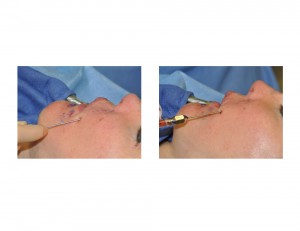Injectable fillers are a very effective method of adding volume to facial wrinkles, folds and regional areas such as the cheeks. The most popular injectable fillers are made of hyaluronic acid materials which have the lowest incidence of complications as they are completely resorbable. Lumps and bumps may occur with their use due to overcorrection and non-linear deposition but they are either self-solving or can be treated by prompt enzymatic digestion with hyaluronidase solutions.
But complications with longer lasting injectable fillers can be more problematic. What makes an injectable filler longer lasting is either a liquid material that does not resorb (e.g., silicone) or the incorporation of non-resorbable particles in the injectate. (e.g. Artefill or Bellafil, Aquamid) While these longer lasting or permanent fillers are generally well tolerated, delayed onset complications with them can occur. These appear as nodules or graulomas that may become periodically inflamed or even infected. Biofilms, aggregates of cells adhered to living or nonliving materials, have been implicated. Areas at higher risk for these type reactions include the nasolabial folds, lips, periorbital and perioral lines, and tear troughs although they can occur anywhere they are injected.
Treatment of these type of injectable filler reactions are more problematic as their non-resorbable nature makes them difficult if not impossible to remove. Treatment options include steroid and 5-fluorouracil injections, oral antibiotics (minocycline), puncture and expression, or surgical excision. Cutting them out is rarely an option due to the scarring and deformity that can result.

Particulation (microliposuction) and fat injection should be reserved for those long-term injectable filler nodules that failed to adequately respond to more traditional injection treatments. The very small size of the cannulas make it capable to be used anywhere on the face without risk of adverse scarring.
Dr. Barry Eppley
Indianapolis, Indiana


